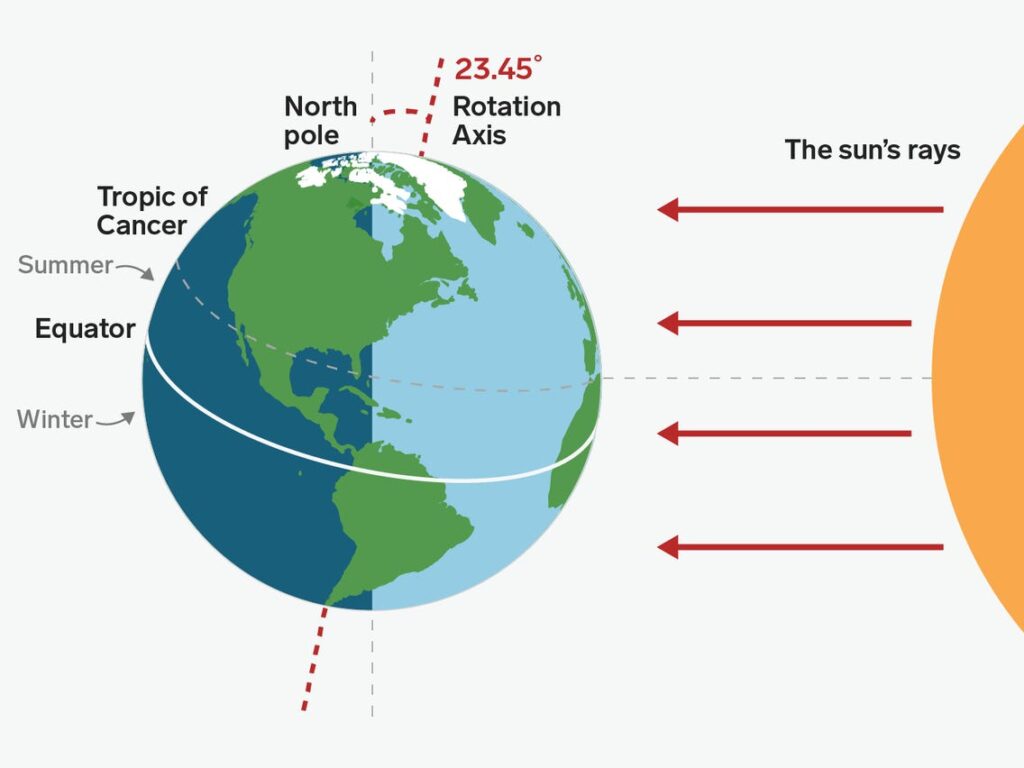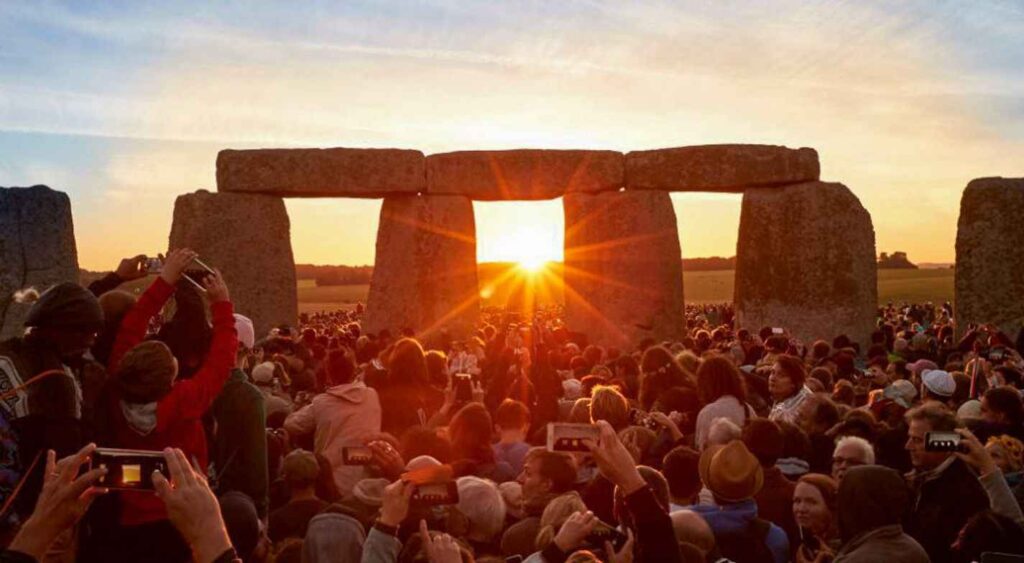Introduction
The June solstice, also known as the summer solstice, is an astronomical event that marks the longest day of the year in the Northern Hemisphere. It’s a moment when the Earth’s axial tilt is most inclined toward the Sun, resulting in extended daylight hours and the shortest night. Let’s explore the significance, science, and cultural aspects of this celestial occurrence.

Astronomical Details
The longest day of the year, occurring on June 21st is known as the summer solstice in the Northern Hemisphere. This event is characterized by the Sun reaching its highest and most northern point in the sky, resulting in the maximum amount of daylight for the year. Here are the key astronomical details that explain why this day is significant:
1. Earth’s Axial Tilt: The Earth’s axis is tilted at an angle of approximately 23.5 degrees relative to its orbit around the Sun. This tilt is responsible for the changing seasons and the variation in daylight hours throughout the year. On June 21st, the Northern Hemisphere is tilted toward the Sun, allowing it to receive more direct sunlight for a longer period of the day.
2. Sun’s Path: During the summer solstice, the Sun takes its longest and highest path across the sky. This means that the Sun rises earlier and sets later than on any other day of the year. At noon, the Sun is at its highest point in the sky for the year, which is directly overhead at the Tropic of Cancer, located at 23.5 degrees north latitude.
3. Duration of Daylight: The duration of daylight on June 21st varies depending on your location. For example:
- In equatorial regions, the length of day and night remains relatively constant throughout the year.
- In mid-latitude regions, like Europe and North America, daylight can last for over 16 hours.
- In areas within the Arctic Circle, the phenomenon of the midnight sun occurs, where the Sun does not set at all and remains visible for a full 24 hours.
4. Seasonal Marker: The summer solstice is a crucial marker in the Earth’s orbit around the Sun. It signifies the start of astronomical summer in the Northern Hemisphere. This period is characterized by the warmest temperatures and the longest days, which gradually shorten as the Earth continues its orbit.
5. Solar Declination: On June 21st, the solar declination is +23.5 degrees, meaning the Sun’s rays are directly striking the Tropic of Cancer. This is the northernmost point where the Sun’s rays are directly overhead at noon. After this date, the Sun’s direct rays begin to move southward again.
Understanding these astronomical details helps to explain why June 21st is the longest day of the year. It highlights the intricate relationship between the Earth’s tilt, orbit, and the Sun’s position, all of which combine to create the seasons and the varying lengths of day and night throughout the year.
Longest Day in the North

- Sunlight Abundance:
- During the June solstice, the Northern Hemisphere tilts toward the Sun, resulting in extended daylight hours.
- The North Pole experiences its greatest tilt toward the Sun during this time, making it the longest day of the year north of the equator.
- Variation by Latitude:
- The effect of the solstice is most pronounced in locations farther from the equator.
- In temperate zones, daylight hours are significantly extended, while tropical areas experience only slightly longer days.
- Within the Arctic Circle, the mesmerizing Midnight Sun occurs, where the Sun doesn’t set at all.
Shortest Day in the South
The shortest day of the year in the Southern Hemisphere, known as the winter solstice, occurs when the South Pole is tilted farthest away from the Sun. This event typically happens around June 21 and marks the official start of winter.
- Astronomical Explanation: The winter solstice occurs when the Sun reaches its lowest point in the sky at noon in the Southern Hemisphere. This happens because the Earth’s axial tilt positions the South Pole away from the Sun, resulting in the shortest amount of daylight for the year.
- Cultural Significance: Many cultures in the Southern Hemisphere have traditions and festivals to mark the winter solstice. For example, the Inti Raymi festival in Peru celebrates the Sun god and is a time for reflection and renewal.
- Daylight Duration: On the winter solstice, regions in the Southern Hemisphere experience their shortest day and longest night. Some areas, particularly those closer to the Antarctic Circle, may have very limited daylight or even continuous darkness.
- Environmental Impact: The decreased daylight and lower temperatures during the winter solstice affect the natural world significantly. Plant growth slows, and animals may enter periods of hibernation or reduced activity. This period is crucial for the natural cycles of many species.
Understanding the shortest day in the Southern Hemisphere helps us appreciate the delicate balance of Earth’s tilt and orbit, and how these astronomical phenomena shape the environment and cultural practices.
Cultural Significance
The cultural significance of celestial events like solstices and equinoxes highlights humanity’s deep connection with the cosmos. These moments, marked by the changing position of the Sun in the sky, have inspired traditions, rituals, and celebrations across different cultures.
- Historical Observances: Many ancient civilizations built monuments aligned with the solstices. Stonehenge in England and Machu Picchu in Peru are prime examples, showing how our ancestors used these events to mark time and seasons.
- Festivals and Rituals: Solstices often bring about festivals that celebrate light, renewal, and nature. For instance, in Sweden, Midsummer festivities include dancing around maypoles and feasting, while in Peru, the Inti Raymi festival honors the Sun god with music, dancing, and elaborate ceremonies.
- Modern Celebrations: Today, people still gather at historic sites, participate in local customs, and create new traditions to honor these celestial events. From yoga sessions during sunrise at solstices to lantern festivals during equinoxes, modern interpretations keep these age-old practices alive.
- Symbolic Meaning: Solstices and equinoxes symbolize balance, change, and the cyclical nature of life. They remind us of our connection to the Earth and the cosmos, influencing art, literature, and spirituality across cultures.
Exploring the cultural significance of these celestial events reveals a rich tapestry of human history and creativity, illustrating how the movements of the Sun continue to inspire and shape our world.
Conclusion:
The longest day of the year, occurring on June 21st, is a remarkable astronomical event known as the summer solstice. This day marks the peak of daylight hours in the Northern Hemisphere, with the Sun reaching its highest point in the sky. The summer solstice has profound implications for both nature and human culture. It heralds the official start of summer, bringing extended daylight that fosters plant growth and animal activity. Culturally, June 21st is celebrated with various festivals and traditions worldwide, from gatherings at Stonehenge to Midsummer festivities in Scandinavia. This day is a powerful reminder of the Earth’s intricate dance around the Sun, influencing our environment, traditions, and ways of life. The longest day encourages us to appreciate the natural cycles and the light that sustains life on our planet.
FAQ’s
Q. What is the longest day of the year?
A: The longest day of the year, known as the summer solstice, occurs on June 21st in the Northern Hemisphere. It marks the day with the most daylight hours.
Q. Why does the longest day of the year happen on June 21st?
A: The longest day happens on June 21st because the Northern Hemisphere is tilted closest to the Sun on this date, resulting in the maximum amount of daylight.
Q. What is the significance of the Tropic of Cancer on June 21st?
A: On June 21st, the Sun is directly overhead at noon at the Tropic of Cancer, which is at 23.5 degrees north latitude. This marks the Sun’s most northern position in the sky.
Q. Is June 21st the first day of summer?
A: Astronomically, yes. The summer solstice marks the first day of astronomical summer in the Northern Hemisphere.
Q. What is the “midnight sun”?
A: The midnight sun is a natural phenomenon during which the Sun remains visible at midnight during the summer months. It occurs in regions within the Arctic Circle around the time of the summer solstice.
Q. How does the longest day affect plants and animals?
A: The extended daylight hours promote plant growth and influence animal behaviors, such as mating and feeding patterns, as they adapt to longer days and increased warmth.



![kihikila.in[21 st june] (1)](https://www.kihikila.in/wp-content/uploads/2024/06/kihikila.in21-st-june-1.jpg)
